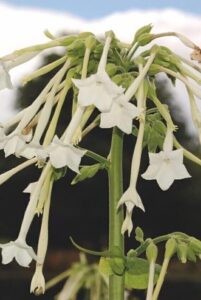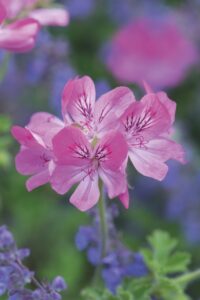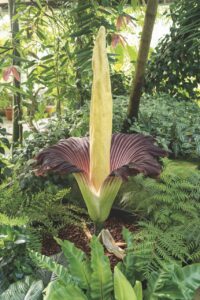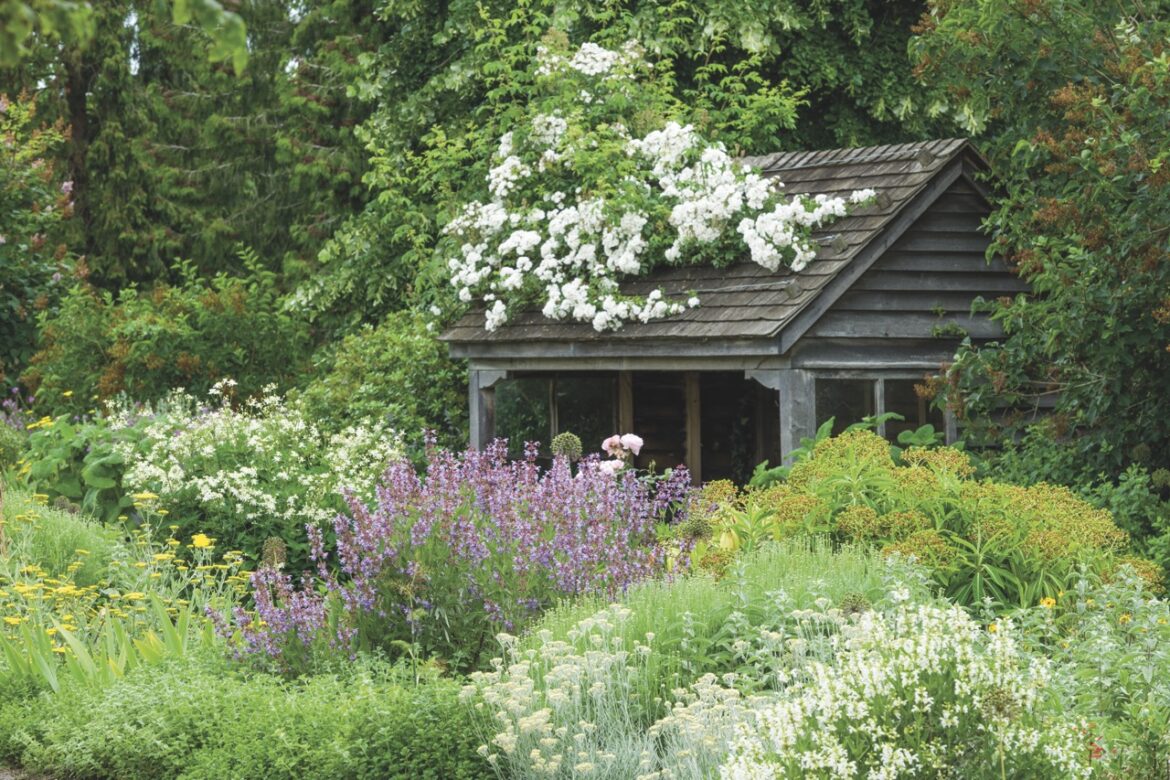Drawing inspiration from the sweet perfume of Cambridge University Botanic Garden, Sally Petitt discusses planting for scent
The appeal of a garden can vary greatly between one person and another. Keen horticulturists often tend to be interested in individual plants, artists in the visual appeal and casual visitors might be drawn to calming atmospheres. But a good garden relies on much more than an individual aspect; when combined, the senses of sight, touch, sound, taste and smell draw much more meaning from an outdoor space.

Nicotiana sylvestris – flowering tobacco – is a plant that not only produces pretty flowers, but lots of fragrance in the evening too
It’s hard for me to spend time in a garden without observing its individual shapes, forms and colours, as well as the combined result; running my hands through tactile swathes of grasses, listening to the gentle rustling of leaves in a breeze, taking a sneaky taste of freshly picked peas or sticking my nose into a bloom for a hit of fragrance. For many, scent is key to adding value to gardens – while appealing to our senses, it also attracts a range of pollinating insects.
Why do some flowers produce scent?
Floral scent is a tool used by plants to attract insects to ensure pollination and the production of seeds. Roses are perhaps the most familiar scented flower, with many varieties producing appealing fragrances, including fruity, tea, myrrh and musk, but a range of trees, shrubs, perennials, annuals and climbers also produce scented flowers.
Some plants have adapted to ensure their appeal is greatest when a specific pollinator is likely to be present – one of the most well-known examples being Darwin’s orchid (Angraecum sesquipedale), with flowers that only release a scent at night to attract a particular hawkmoth (Xanthopan morganii var. praedicta) to pollinate the flower while feeding on its nectar. Some plants, such as our celebrated titan arum (Amorphophallus titanum), smell particularly unpleasant to us, but desirable to pollinating gnats and flies.
However, not all flowers rely on scent for reproduction. Some, such as grasses and many trees, are wind-pollinated, so don’t invest energy into making scent. Others attract pollinators using colour, shape or nectar guides instead. In some cultivated plants, human breeding for traits like bigger blooms has reduced or eliminated scent – especially in certain modern roses and lilies.

Pink Capitatum brings vivid colour and delightful fragrance
Many plants, especially those from the Mediterranean, even have scented leaves and stems, and while this scent can be attractive to us, it can act as a deterrent to animals that might otherwise regard it as a food source. When crushed, plants such as lavender, mint and thyme release a scent, which can also be released and fill the air in rain or hot weather.
Adding scent to your garden
It’s easy to introduce scent into your own garden. While you might not wish to have a dedicated Scented Garden like the Botanic Garden’s, careful selection can provide a succession of fragrance through the year.
Scented plants such as Daphne bholua ‘Jacqueline Postill’ produce scent during the winter, as well as welcome flowers. In summer, a mixed planting of herbaceous perennials and roses can bring a romantic look to the garden – but add scented kinds such as Rosa ‘Madame Hardy’ or ‘Dannahue’ and your outdoor space will be transformed to a completely different level.
A single lavender bush (Lavandula) beside a path can fill the air with fragrance, especially if it’s brushed as you walk past it, while flowering tobacco plants (Nicotiana sylvestris) will pump out evening fragrance. Additionally, scented plants such as geraniums Pelargonium ‘Pink Capitatum’, Pelargonium tomentosum or scented blooms of Dianthus ‘Mrs Sinkins’ will attract a diverse range of beneficial insects such as butterflies, moths and bees to your garden.
As well as successional planting to ensure year-round fragrance, clever design can enhance the impact of scent. Here at the Botanic Garden, our Scented Garden is set in a gentle hollow to trap and concentrate fragrance, with raised beds that allow visitors to appreciate the plantings at close hand. At home, consider positioning scented plants around patios, doorways or seating areas where their fragrance can be easily enjoyed as you relax or entertain.
No matter how large or small your garden, there will always be space for a touch of fragrance!

Titan arum sits at the other end of the spectrum but still attracts pollinators
Gardening jobs for July
- Continue deadheading perennials and roses, but also tender perennials such as dahlias and annuals, to encourage flowering.
- Keep container plants and new plantings watered using water from a water butt or grey water, but don’t worry about your lawn, it will recover over time.
- Cut back and feed hardy geraniums after the first flush of flower – this will help to encourage another flush of flower to appear later in summer.
- Keep harvesting early vegetable crops to enjoy yourself, but also to encourage further cropping.
Top scented plants
- Lavandula ‘Hidcote’ A bushy dwarf lavender with fragrant silver-grey foliage and spikes of purple flowers. A must-have for hot, sunny spots.
- Sarcococca confusa (sweet box) An evergreen shrub that reaches two metres in height, with cream-white flowers that fill the air with fragrance in the new year.
- Lonicera periclymenum ‘Serotina’ (honeysuckle) A climbing plant that will scramble over fences and arches, producing highly fragrant pink and red tubular flowers.
- Lathyrus odoratus (sweet pea) Highly fragrant annual climbers with pea-like flowers in a range of pastel shades. This requires regular picking to encourage new flowers.
- Nicotiana alata (jasmine tobacco) An easy annual, suitable for borders and pots, with flowers that will fill the air with heady fragrance in the evenings.
Sally Petitt is head of horticulture at Cambridge University Botanic Garden. From gardens for the senses to beds of roses, explore more of Sally’s gardening tips.

